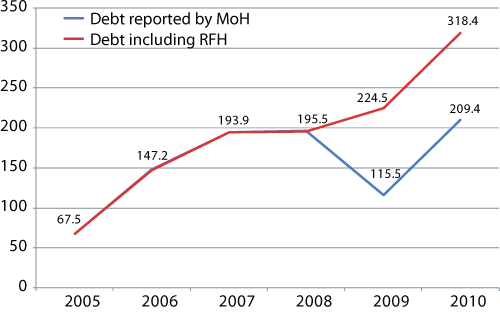—
HPI Network > HPI - Health Policy Institute > Analyses > Ministry of finance introduced Program of stability for years 2011 – 2014
Ministry of finance introduced Program of stability for years 2011 – 2014
Monday, 29. August 2011, 12:31 — Peter Pažitný
Ministry of finance published Slovak Program of stability for years 2011 – 2014 [in Slovak], in which it presents program of consolidation of public finance. Main goals of the Program of stability are:
- Lower the deficit of public administration under the boundary of 3% of GDP in 2013 (Table 1) and stabilize and start to decrease the public debt (Table 2).
- Fulfill the planned deficit in the amount of 4.9% of GDP in 2011 by realisation of consolidating measures.
- Lower the deficit of public finance to the level of 3.8% of GDP in 2012.
|
2011 |
2012 |
2013 | |
|---|---|---|---|
| Deficit of public finance as a % of GDP |
-4.9% |
-3.8% |
-2.9% |
Source: MoF SR, 2011
|
2009 |
2010 |
2011 |
2012 |
2013 |
2014 |
|
|---|---|---|---|---|---|---|
| Gross debt of public finance as a % of GDP |
35.4% |
41.0% |
44.1% |
45.3% |
45.3% |
45.2% |
Source: MoF SR, 2011
Ministry of finance plans to perform the consolidation of public finance by three types of measures:
- Stabilising (their core are savings in the expenditure part and temporary increasing of VAT from 19% to 20%).
- Structural (their core is improvement of entrepreneurial environment, reform of tax system and support of knowledge economy).
- Targeted on long-term sustainability (their core is recovery and privatisation of state companies, changes in pension system and health care and improvement of institutional framework of fiscal policy)
Settlement with refundable financial help from 2009
Previous government provided in December of 2009 to hospitals from state financial assets refundable financial help (RFH) in the amount of 130 mil. €, from which 109 mil. € went to state hospitals.
In January 2010 we wrote, that providing RFH from state assets enables to camouflage the deficit of public finance and that the real deficit will be calculated to the balance of that government, which will admit that RFH provided to hospitals are uncollectible and will reclassify them to net expenditure, which will be by ESA95 calculated to the deficit. By this technique of debt relief via RFH could Fico’s government save hospitals before election without admitting it in the budget.
Current government correctly reclassified refundable financial help (RFH) provided to hospitals to non-refundable financial help (non-RFH) and again correctly calculated it not to the deficit of 2011, but to the deficit of 2009, that means to the year, when the RFH was provided. The difference in perception documents Chart 1. Blue curve of the debt is preferred by Ministry of Health of Slovak republic (MoH SR) (and occurs not only in documents of previous, but also the current management), while correct should be the red curve of debt, which in the amount of debt calculates also the volume of provided refundable financial help in 2009. That’s why is the view of MoF SR, to calculate the provided RFH in 2009 to deficit of 2009 correct.
Chart 1: Difference in the amount of debt without calculating RFH in 2009 in mil. €

Source: Calculations of HPI on the basis of data of MoH SR, 2011
Settlement of debt of hospitals for 2010
Similar as non-RFH (non-refundable financial help) provided in 2009 MoF SR calculated to 2009, it also very correctly calculated to the deficit of 2010 unprofitable mangement of hospitals in the amount of 79,3 mil. € (0,1% of GDP) for 2010. MoF SR warns, that unsufficient measures in the past lead in these companies (besides hospitals it were also the railways) to their unprofitable management, which the government has to finance today.
Position of health care in Program of stability 2011 – 2014
Ministry of finance in the area of health care identified as important these measures:
- in pharmaceutical policy
- generic prescription
- referencing of prices to three lowest prices in EU
- defining of rate cost efectiveness
- enabling of sale of OTC drugs without prescription out of pharmacies
- strenghtening of transparency and independency of the process of drug categorization
- restraining possible conflicts of interest of physicians by compulsory publicizing their training by pharmaceutical companies on the Internet
- in hospital care
- introduction of payment for diagnostic group (DRG), by which the payments for standard performance become equal
- debt relief of hospitals and their transformation to joint stock company with the goal of making hard budget constraints
- for debt relief of hospitals should be used the incomes from privatisation of companies with the property participation of state
What is missing in Program of stability?
We realize the restricted space of that kind of document and that’s why we understand the fact, that Ministry of Health of Slovak republic was not able to enumerate all tools of health care policy designed for stabilisation of public finance.
Program of stability should in our opinion not lack these essential measures:
- Financial stabilisation of VšZP (state-owned General Health Insurance Company). It will require probably 130 mil. € to cover the cumulated loss from 2008 to 2010. The loss in 2010 attained 70 mil. € and moreover according to the ÚDZS it is necessary to settle up the accounts receivable and costs for health care from the period before 2011, for which are not made technical reserves. ÚDZS estimates these risks on 50 to 60 mil. €.
- Separation and privatization of VŠZP. It is important because of lowering the political impacts on decission process of VŠZP and also for stabilisation and standardisation of insurance market. The intention to enter the Slovak market of health care insurance is not denying Allianz and its ambitions also confirmed AXA. Privatization of VŠZP would at the same time be a considerable source of revenue to state budget, which could be used for debt relief or modernization of hospitals.
- Defining the amount and technique of debt relief of hospitals. According to our estimation the costs for debt relief could achieve even 500 mil. €. The reason is inhereted indebtedness from the previous government, the growth of the debt since the advent of new government and also the liabilities, which are currently not reported as debt, because they are in the maturity period. Because maturity periods are by medialised information of suppliers more than 300 days, then volume of these liabilities can be in the amount of 150 to 200 mil. €.
|
Liabilities |
Amount |
Data source |
|---|---|---|
| Liabilities after maturity (principal) of health care facilities in the scope of MoH SR to Dec 31, 2010 |
209 mil. € |
Report about development of debts in the health care resort |
| Estimated growth of liabilities after maturity (principal) of health care facilities in the scope of MoH SR in 2011 |
100 mil. € |
Estimation of HPI |
| Estimated volume of liabilities in the maturity period, which are not classiefied as debt, but it will be necessary to pay them during transformation |
150 to 200 mil. € |
Estimation of HPI |
| The whole amount needed for debt relief |
459 to 509 mil. € |
News
The amendment of the Decree on emergency medical service
Health insurance companies returned over 400 thousand €
The HCSA received 1,647 complaints last year
A half million people will earn more
Most of public limited companies ended in the black
Debt of hospitals on premiums has grown to nearly € 105 MM
Slovak health care may miss € 250 million next year
Profits of HIC amounted to € 69 mil. last year
Owners of Dôvera paid out money but did not paid taxes
Like us on Facebook!
Our analyses
- 10 Years of Health Care Reform
- New University Hospital in Bratislava
- Understanding informal patient payments in Kosovo’s healthcare system
- Analysis of waiting times 2013
- Health Policy Basic Frameworks 2014-2016
- Analysis of informal payments in the health sector in Slovakia
- Serbia: Brief health system review
developed by enscope, s.r.o.
